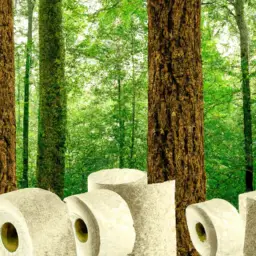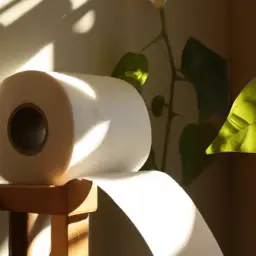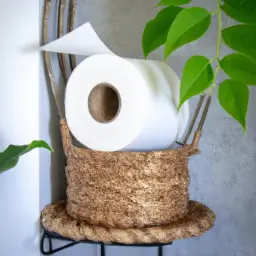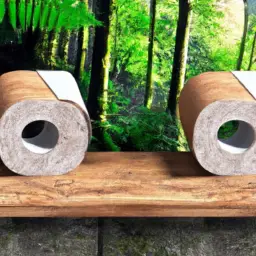Hey there! I’ve got a game-changing swap to share with you: switching from traditional to eco-conscious toilet paper.
In this article, I’ll walk you through the environmental impact of traditional toilet paper and the benefits of making the switch.
We’ll dive into the world of sustainable alternatives like bamboo toilet paper and compare different eco-conscious options.
Plus, I’ll give you some tips for making the ultimate toilet paper swap.
Let’s make a difference, one roll at a time!
The Environmental Impact of Traditional Toilet Paper

As a consumer, I was shocked to learn about the significant environmental impact caused by the production and disposal of traditional toilet paper. The environmental consequences of using traditional toilet paper are far-reaching and alarming. One of the most pressing issues is deforestation. To produce toilet paper, countless trees are felled every year, leading to the destruction of natural habitats and loss of biodiversity. This deforestation not only contributes to climate change but also disrupts ecosystems and threatens the survival of many species.
Additionally, the manufacturing process for traditional toilet paper is incredibly resource-intensive. It requires large amounts of water, energy, and chemicals, which all contribute to pollution and greenhouse gas emissions. Moreover, the disposal of toilet paper adds to the mounting waste problem. In landfills, toilet paper decomposes slowly and releases methane, a potent greenhouse gas that further exacerbates climate change.
Understanding the environmental consequences of traditional toilet paper has made me realize the urgent need for a more sustainable alternative. By making a simple switch to eco-conscious toilet paper options, such as recycled or bamboo toilet paper, we can significantly reduce the demand for virgin pulp and help protect our forests and the planet.
Benefits of Switching to Eco-Friendly Toilet Paper

By switching to eco-friendly toilet paper, I can make a significant impact on reducing deforestation and minimizing environmental pollution. Not only does eco-friendly toilet paper help to preserve our forests, but it also promotes sustainable bathroom practices.
One of the key benefits of using eco-friendly toilet paper is that it is made from recycled materials or sustainable sources, such as bamboo or hemp. This means that fewer trees are being cut down to produce toilet paper, helping to protect our precious forests and the wildlife that depends on them. Additionally, eco-friendly toilet paper is often produced using environmentally friendly manufacturing processes that minimize water and energy consumption, further reducing its carbon footprint.
To illustrate the benefits of switching to eco-friendly toilet paper, here is a comparison table between traditional and eco-friendly toilet paper:
| Traditional Toilet Paper | Eco-Friendly Toilet Paper |
|---|---|
| Made from virgin trees | Made from recycled materials or sustainable sources |
| Often bleached with harsh chemicals | Produced using environmentally friendly processes |
| Contributes to deforestation | Helps to preserve forests and wildlife |
| Creates more waste and pollution | Minimizes environmental impact |
Exploring Bamboo Toilet Paper as a Sustainable Alternative

I have discovered that using bamboo toilet paper as a sustainable alternative is a highly effective and eco-conscious choice. One of the main reasons for this is the way bamboo is sourced. Bamboo is a fast-growing plant that requires minimal water and no pesticides or fertilizers to grow. It can be harvested in just a few years, making it a highly renewable and sustainable resource. Additionally, bamboo forests help to absorb more carbon dioxide from the atmosphere compared to other types of forests, further contributing to its eco-friendly nature.
The manufacturing process of bamboo toilet paper is also more environmentally friendly than traditional toilet paper. The production of bamboo toilet paper uses less water and energy compared to the production of toilet paper made from trees. Furthermore, the manufacturing process of bamboo toilet paper produces fewer greenhouse gas emissions and less waste.
Comparing Eco-Conscious Toilet Paper Options

When comparing eco-conscious toilet paper options, it’s important to consider factors such as material sourcing, manufacturing processes, and environmental impact. One key aspect that consumers often take into account is the cost comparison of eco-conscious toilet paper options. While traditional toilet paper may be cheaper upfront, eco-friendly alternatives may have a higher price tag due to their sustainable production methods and higher quality materials. However, it’s essential to consider the long-term benefits and savings that come with using eco-conscious options.
Another crucial factor to consider is consumer perception of eco-friendly toilet paper choices. Many individuals are becoming more conscious of their environmental impact and are actively seeking out products that align with their values. As a result, the demand for eco-friendly toilet paper has been steadily increasing. Consumers appreciate knowing that the toilet paper they use is made from renewable resources, produced using sustainable practices, and is biodegradable. This positive perception not only benefits the environment but also gives consumers a sense of satisfaction in making a conscious choice for a greener future.
Tips for Making the Ultimate Toilet Paper Swap

To ensure a successful transition, I recommend researching and comparing different eco-conscious toilet paper brands for their sustainability features and comfort. When it comes to making the ultimate toilet paper swap, there are a few tips that can help you in your journey towards reducing waste and choosing more environmentally friendly options.
Firstly, consider exploring toilet paper alternatives. There are various options available such as bamboo toilet paper, recycled toilet paper, and even toilet paper made from sugar cane or wheat straw. Each alternative has its own unique set of benefits, so it’s important to find the one that aligns with your values and preferences.
Secondly, take a look at the packaging. Opt for brands that use minimal or plastic-free packaging, as this can further reduce waste and environmental impact. Additionally, consider purchasing in bulk to minimize packaging waste even more.
Lastly, don’t forget to consider the comfort factor. Some eco-conscious toilet paper options may have a different texture or thickness compared to traditional brands. Look for reviews or sample packs to ensure that you find a brand that meets your comfort needs.
Conclusion
In conclusion, making the ultimate toilet paper swap from traditional to eco-conscious options is a small yet impactful change we can make to reduce our environmental footprint.
By switching to sustainable alternatives like bamboo toilet paper, we can help protect forests, conserve water, and support ethical manufacturing practices.
With the wide range of eco-friendly options available, it’s easier than ever to make a positive difference in our daily lives.
Let’s make the switch and contribute to a greener future.


